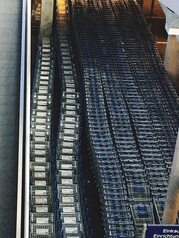Connectivity and Stability: Key to Real Estate Value

The connectivity and stability of a location are determining factors in the valuation of real estate properties. In a world where access to services and adequate infrastructure are essential, understanding how these elements influence appreciation is crucial for buyers and investors. Discover why choosing your place of residence wisely can translate not only into quality of life but also into significant growth in the value of your investment.
The importance of infrastructure in urban development
Infrastructure plays a fundamental role in urban development, as it acts as the backbone that supports the growth and functionality of cities. A well-planned road network, efficient public transportation systems, and basic services such as water, electricity, and sanitation are essential to ensure an adequate quality of life. The availability of infrastructure not only facilitates the mobility of residents but also attracts businesses and investors looking to establish themselves in areas with access to adequate resources. Consequently, properties located in areas with good infrastructure tend to have higher real estate values due to their appeal to both buyers and renters.
Moreover, infrastructure directly influences the social and economic cohesion of a community. A well-connected environment allows for the constant flow of people and goods, which fosters local economic development and generates jobs. Areas with accessible services tend to experience an increase in commercial and cultural activity, thus contributing to urban dynamism. On the other hand, locations with deficiencies in their infrastructure may face significant challenges, such as stagnation in population growth and a decrease in property value. Therefore, it is crucial for those looking to invest in real estate to consider not only the physical characteristics of a property but also the infrastructural context that surrounds it.
2. How public transportation increases real estate value
Public transportation plays a fundamental role in increasing real estate value, as it facilitates access to various areas of a city, which boosts demand for properties near these infrastructures. Subway stations, bus stops, and trams not only connect residents to their workplaces but also allow them to access essential services like schools, hospitals, and shopping centers. This connectivity is especially valuable in urban environments where traffic can be a daily challenge. As a result, properties located near public transport stops often experience an increase in value due to the convenience they offer to potential buyers or tenants.
Additionally, the presence of an efficient public transportation system can transform an area previously considered peripheral into an attractive location for living and investing. As new routes are developed and existing ones are improved, surrounding areas tend to revitalize and modernize, thereby boosting real estate value. Public investments in infrastructure not only enhance the quality of life for current residents; they also attract new inhabitants and businesses looking to take advantage of these improvements. In this context, those who decide to invest in properties within these emerging areas can benefit significantly by seeing their investment grow over time due to the appeal generated by improved access to public transportation.
3. Digital connectivity: The new standard for modern homes
Digital connectivity has become a fundamental pillar for modern homes, transforming into a standard that buyers consider essential. With the rise of remote work and online education, having a high-speed Internet connection is not just an advantage; it is a necessity. Properties that offer advanced digital infrastructure, such as fiber optics and mesh networks, are highly valued in the real estate market, as they allow residents to maximize their productivity and enjoy a more comfortable daily life. Furthermore, connectivity is not limited to Internet access; it also includes smart services integrated into the home, such as security systems and energy management, which optimize the user experience and enhance efficiency.
Similarly, proximity to emerging technologies and digital platforms can significantly influence the added value of a property. Urban developments that prioritize connectivity are often located near technology centers or innovation hubs, which attracts both young professionals and families seeking a dynamic environment. This trend is driving a shift towards more connected communities where digital infrastructures align with contemporary needs. In this context, a well-connected home not only promises comfort and efficiency for its current residents but also represents a solid investment for the future in an increasingly competitive real estate market.
4. High-demand areas: What makes them attractive?
High-demand areas are often those that offer a balanced combination of connectivity, services, and quality of life. Proximity to efficient public transportation, such as subway or buses, as well as access to major roads, not only facilitates the daily mobility of residents but also attracts those looking to avoid long commutes. Additionally, areas close to shopping centers, prestigious schools, and recreational spaces enhance their appeal by providing a variety of options to meet everyday needs. This solid infrastructure translates into a favorable urban environment that can significantly increase real estate value.
Another key factor that makes these areas attractive is economic and social stability. Areas where investments in urban development have been made tend to experience sustained growth over time. This includes both the increase in new constructions and the renovation of existing spaces, which enhances the aesthetics and functionality of the place. Furthermore, communities with low crime rates and an active sense of civic participation tend to generate a safer and more welcoming environment for their residents. All of this creates a positive perception among potential buyers and investors, further increasing the demand and value of the local real estate market.
5. Economic stability and its impact on the real estate sector
The economic stability of a region is a fundamental pillar that directly impacts the real estate sector. When a locality shows sustained growth in its economy, it translates into an increase in the demand for housing and commercial spaces. Buyers and investors tend to seek areas with prospects for economic development, as this not only ensures greater security for their investments but also the possibility of a constant appreciation in property values. Furthermore, a strong economy often attracts companies and professionals, contributing to a competitive and vibrant environment that further enhances the real estate market.
On the other hand, economic instability can have adverse effects on the real estate sector. In situations where there is financial uncertainty or prolonged recessions, property prices can decrease drastically, affecting not only current homeowners but also potential buyers who hesitate to invest. This cycle can lead to a stagnation of the market and a decrease in interest in certain areas. Therefore, it is crucial for investors to assess not only the current economic situation of a region but also its future projections when making decisions about real estate acquisitions. The combination of effective connectivity and economic stability is what truly ensures sustainable growth in real estate value.
6. Essential services: Education, health, and their influence on added value
Education and health are two of the fundamental pillars that contribute to the development of a community, and their quality can decisively influence the value of properties. When an area has renowned educational institutions, from primary schools to universities, it becomes an attractive option for families seeking to ensure a promising future for their children. This not only increases the demand for housing in the area but also elevates the neighborhood's profile, causing real estate prices to adjust upwards. Families are willing to invest more in properties near good schools, which transforms the dynamics of the local market.
On the other hand, access to adequate healthcare services is equally relevant. Proximity to well-equipped hospitals and clinics provides residents with a sense of security and well-being that also positively impacts property values. A neighborhood that offers accessible medical care attracts people who value their health and that of their loved ones, which translates into greater demographic and economic stability. Thus, both education and healthcare services not only improve quality of life but are also key factors in increasing real estate value in any locality.
7. Strategies for investing in areas with growth potential
When considering investment in areas with growth potential, it is essential to conduct a thorough analysis of real estate market trends and urban developments. Identifying emerging areas that are experiencing infrastructure improvements, such as new roads, public transportation systems, or shopping centers, can be an effective strategy to maximize long-term profitability. Cities that are expanding outward often present interesting opportunities, especially if they have approved development plans that promote the economic and social growth of the region.
Another key aspect to evaluate is the quality of life in these rising areas. Factors such as safety, the availability of educational and medical services, as well as cultural and recreational offerings are aspects that attract both families and young professionals. Investing in properties located in places where these elements are being improved or expanded not only ensures a good quality of life for residents but also guarantees a higher housing demand. Therefore, when choosing an area to invest in, it is crucial to observe not only the current conditions but also the future potential that each location offers.



